|
New Zealand Economic, Business and Educational Benefits
due to participation in the
Southern African Large Telescope (SALT) Project
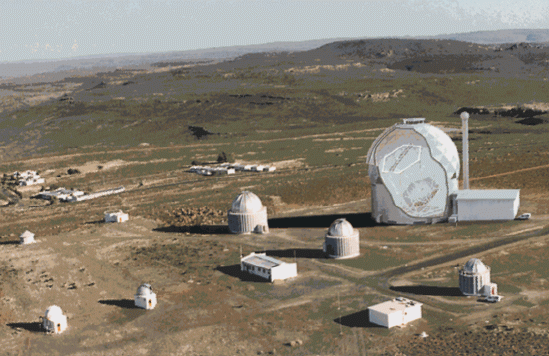
Computer image of the proposed 10-m class Southern African Large Telescope (SALT) superimposed on a photograph of some of the existing telescopes at the South African Astronomical Observatory site near Sutherland, Northern Cape Province.
by Glen Mackie, Peter Cottrell and Phil Yock
Version 1 - 16 December, 1999
|
Executive Summary
 In 1998,
the South African government approved the construction of
the Southern African Large Telescope (SALT) in Sutherland, Northern
Cape Province. The South African government agreed to contribute 50%
of the capital construction costs with the remaining 50% sourced from
international partners. New Zealand has been asked to join the SALT
project.
In 1998,
the South African government approved the construction of
the Southern African Large Telescope (SALT) in Sutherland, Northern
Cape Province. The South African government agreed to contribute 50%
of the capital construction costs with the remaining 50% sourced from
international partners. New Zealand has been asked to join the SALT
project.
This Plan is designed to illustrate the benefits from New Zealand participation in
SALT. There are two main parts to this plan:
- New Zealand Business and Technological Linkages
- New Zealand Educational and Science Promotion Linkages
The potential activities in each of these focus areas are detailed
together with the resultant benefits to New Zealand. The overall goal
is to ensure that maximum economic, business and educational benefits
are derived from New Zealand participation in SALT to advance the
economy, technology and society of New Zealand.
Introduction
In June 1998 the South African Minister of Arts, Culture, Science
& Technology, Mr Lionel Mtshali, announced
(Nature 1998, vol. 393, p. 403) that South Africa has
committed $US10 million towards the construction of the Southern
African Large Telescope (SALT), which would become a flagship science
project in the new South Africa. This is half the construction cost of
this telescope.
SALT will be the largest optical/infrared spectroscopic telescope
in the southern hemisphere. It has a novel efficient, low-cost design
and is a copy of a similar telescope, the Hobby-Eberly Telescope in
Texas. The scientific rationale for New Zealand participation has
already been outlined in Mackie,
Cottrell and Yock (1998). It is now becoming common place for
countries to seek participation in multi-national astronomy projects
located in the best observational sites around the world.
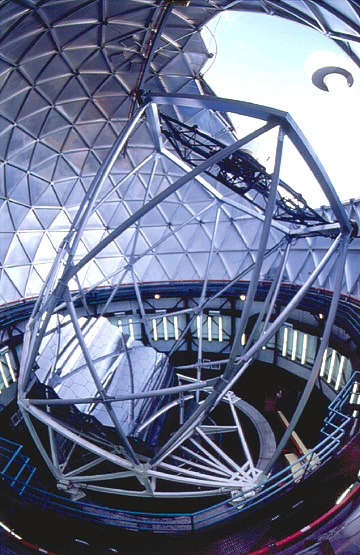
A fisheye lens view of the 10-metre Hobby-Eberly Telescope (HET)
in Texas. SALT will be an almost carbon-copy of HET.
To fund the other half of the construction cost, South Africa is
seeking international partners and the South African Foundation for
Research Development has noted that "good progress has been made in
identifying partners" - potential collaborators include Poland, New
Zealand and universities in the United States of America and
Germany. As of December 1999, approximately 85% of the total cost has been
found (Nature 1999, vol. 399, p. 510) due to firm commitments from the
Polish government, and universities in Germany and the U.S.A. These
commitments have ensured the building of SALT.
The ground breaking ceremony for the start of construction of SALT will be
held in early 2000.
New Zealand has been invited to join the SALT project, and the astronomy
and astrophysics community has identified New Zealand participation in
SALT as its main recommendation for future growth (
Cottrell
and Mackie 1998).
A New Zealand consortium of scientists, engineers and information
technologists are seeking partnership in SALT at the 5% level, which
would be a viable contribution to the collaboration. Part of New
Zealand's contribution could include a substantial contract to build
one of the telescope's initial instruments in New Zealand that would
provide opportunities for optical design and fabrication within the
universities and Crown Research Institutes. The project would provide
substantial spin-offs in a number of technological fields - optical
engineering and fabrication and detector technology.
This document is provided to illustrate the important business
opportunities and educational advantages that could be made if New
Zealand joined the SALT project.
Objectives of SALT
SALT is being constructed for two primary missions:
- International Mission
- South Africa-specific Mission
Participation by New Zealand therefore not only encourages local
economic and business opportunities but also allows New Zealand to be
actively involved in the highest profile science and technology
project in Southern Africa that is a key development in the future
social and economic growth of the new South Africa. SALT has a
lifetime of at least 30 years.
Economic and Business Benefits to New Zealand
Industrial Capabilities
- High Resolution Spectrograph
New Zealand astronomers and
optical designers and engineers have an excellent track record in
building high resolution spectrographs (HRS). Building a HRS for SALT
is a major step-up into high tech, high tolerance design and
manufacturing and will need careful planning and upgraded systems and
an increased skills base (ie. state-of-art laboratory and workshop,
skilled optical technicians and engineers, CCD detector
expertise).
To build a HRS for SALT New Zealand would require
- An HRS Project Team consisting of astronomers, optical designers and
engineers, software engineers, CCD detector engineers.
- Project Laboratories:
To be setup at University of Canterbury optical shop
and Industrial Research Limited (Lower Hutt, Auckland).
The future benefits are numerous given that New Zealand could then
competitively bid for next-generation HRS instrumentation for SALT and
other large telescopes (HET, Keck, ESO-VLT, Gemini North and South,
Magellan) and other similar optical technology projects. In the future
such skills may allow New Zealand involvement in satellite and
planetary mission instrumentation projects. The immediate future
capabilities and outputs include
- A capacity to build competitive international quality high resolution
spectrographs.
- A reinvigorated high-tech optical design and manufacturing base available for
local projects
- A new local knowledge and skills base in low light level detector technologies
(eg. CCDs), camera design and manufacturing capabilities.
- Building on a Legacy - Previous and current optical technology projects
Recent times have seen several major optical technology projects being
completed in New Zealand.

Mount John University Observatory 1-metre telescope
The University of Canterbury has
successfully built the McLellan 1-metre telescope at Mount John
University Observatory. This facility is the largest aperture optical
telescope in New Zealand. The optics of this 1-metre Dall-Kirkham reflecting
telescope were polished by optical engineers from the DSIR's Physics and
Engineering Laboratory (now Industrial Research Ltd.). The mechanical and
electronic work was done by Physics
Department workshop staff at the University of Canterbury.
First light was in 1986 March.
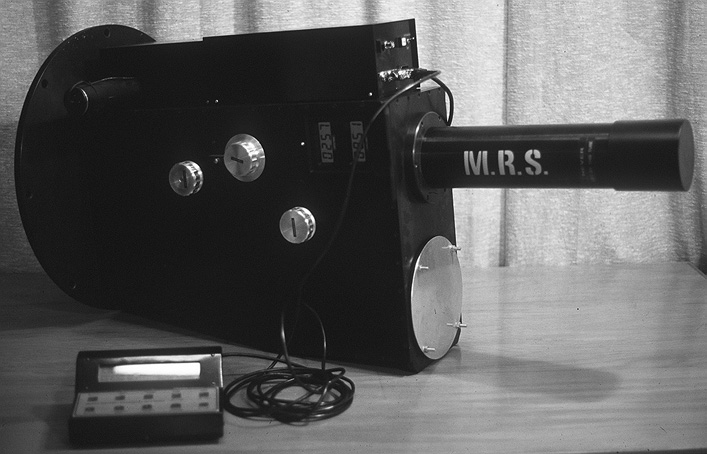
Mount John University Observatory Medium Resolution
Spectrograph. It is ideal for acquiring spectra with a small-medium
size telescope, over both an extended wavelength interval and
spatially, to gain a broad perspective of the astrophysical parameters
of the objects.
The Mount John University Observatory Medium Resolution
and Echelle Spectrographs were also built at the University of
Canterbury and presently, a new high resolution echelle spectrograph,
HERCULES (High Efficiency and Resolution Canterbury University Large Echelle
Spectrograph), is under construction and expected to be completed in 2001.
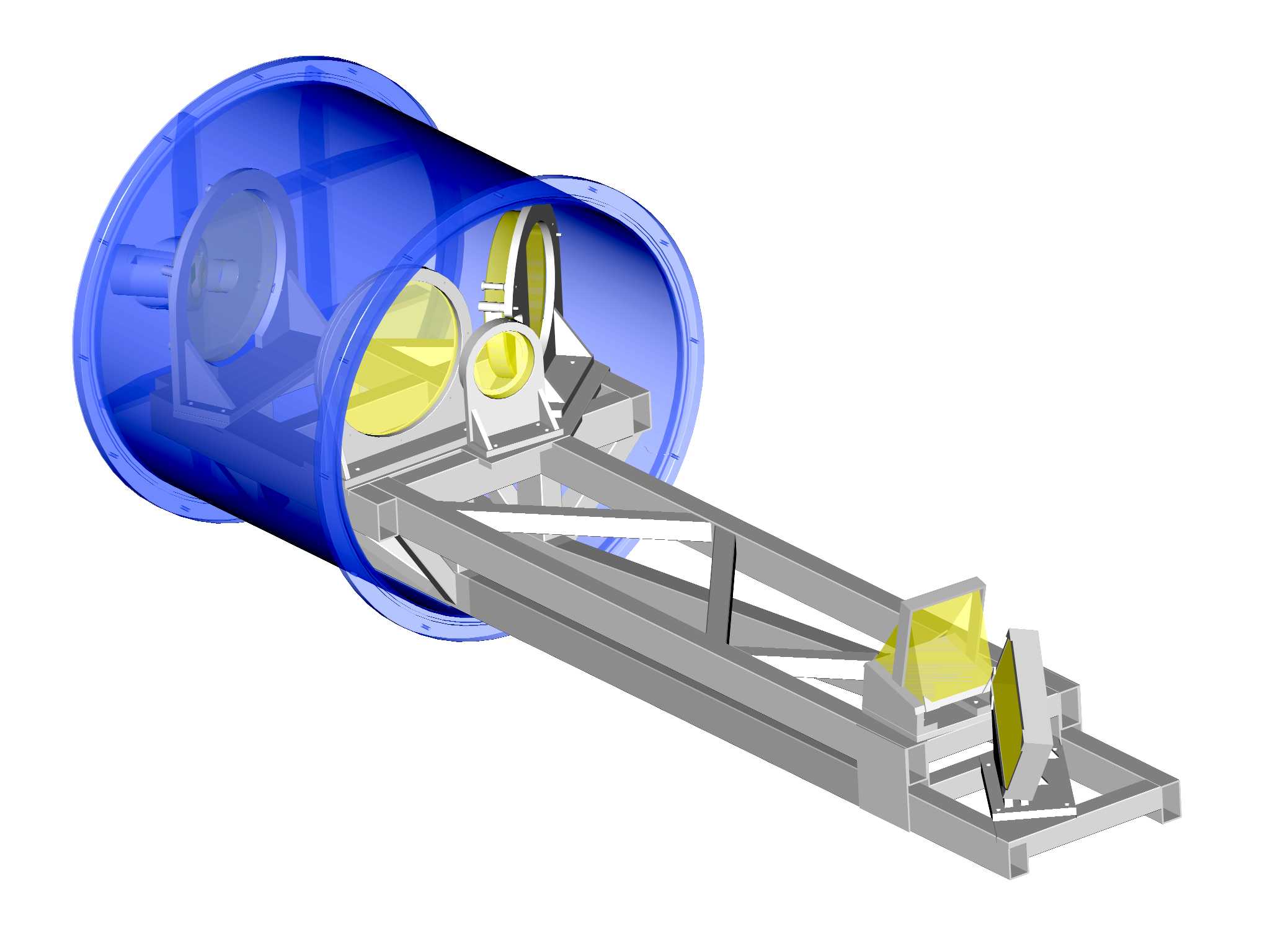
A schematic design diagram of the Mount John University
Observatory HERCULES Spectrograph. It's ultra-high resolution will allow
accurate measurements of chemical abundances and velocities of bright stars
using the 1-metre McLellan telescope.
Optical technology projects are not limited to the South Island. Dr
David Beach of Industrial Research Limited, Auckland has developed a
novel, fast f-ratio imaging camera called KiwiStar. A version of
KiwiStar has already been sold to Los Alamos National Laboratory.
KiwiStar has unique optical
properties that also lend it towards astronomical imaging and its use
in a robotic telescope is being considered presently.
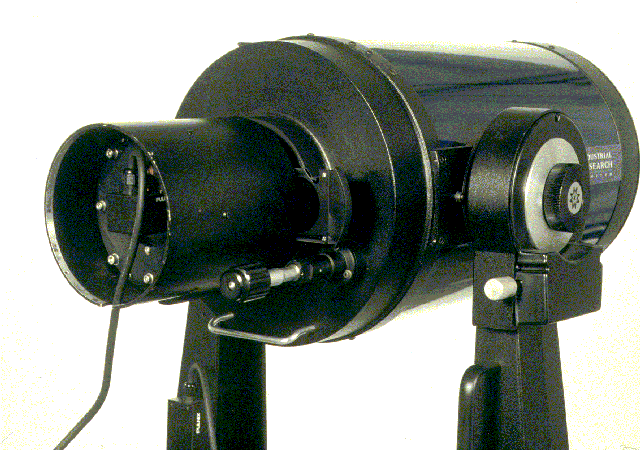
KiwiStar prototype
Technology Linkages
- Other Optical, Electronic and Systems Technologies
Apart
from the specific technologies associated with building a HRS there
are other new technologies that will be important parts of SALT. These
comprise new optical systems (the primary and secondary mirror
systems), micro-positioning, dynamic control systems and precision
sensing. The linkages for New Zealand with such technologies may come
via exchange visits (see below).
- Information Technologies
SALT will be at the cutting edge
of new initiatives in computer control, (Artificial Intelligence),
Integrated sub-systems and data transfer and retrieval. New Zealand
astronomers and researchers would participate in observations via the
Internet, and will be able to analyse their data in real-time via
high-speed data transfer. Local data centres would be required at one
or more major astronomy centres in New Zealand.
- University-Crown Research Institute Linkages
A joint
project to build a HRS in New Zealand would forge a unique
link between Universities (eg. University of Canterbury, University
of Auckland and Victoria University Wellington) and the Crown
Research Institute (Industrial Research Limited).
Exchange of Technologists/Scientists
It is possible that New Zealand could send software designers, optical
technicians and detector engineers to SALT on an exchange basis as part of New Zealands
participation in SALT operations.
The key industrial and technological outcomes will be
- Development of an optical design and manufacturing base
- Ability to bid for and construct major optical spectrographs (and other optical
instruments) for international projects
- Participation in new technology programmes
Economic benefits to New Zealand
The cost benefits to New Zealand can be estimated. The approximate
total cost of a High Resolution Spectrograph is $NZ 3 million (based on the current
cost of the U.Texas HET-HRS). The probable cost of a New Zealand-built
HRS could be 25-35% less however. Hence similar instruments
built to fulfil other contracts will bring into the country similar revenue.
Hence the ability to design and build high resolution spectrographs
and similar instruments or detectors would lead to a multi-million dollar industry.
Once an optical design and manufacturing base has been established
other optical instrumentation projects can also be undertaken.
Educational Benefits to New Zealand
SALT has numerous benefits for education and science and technology
promotion in New Zealand. SALT may be regarded as a virtual
telescope. It could reside anywhere on Earth, and in fact
astronomers will usually use it and obtain their observations via the
Internet rather than travel to South Africa for observations.
Promoting science and technology careers
New Zealand school children will be inspired by the capabilities of
SALT and a New Zealand designed and constructed HRS
instrument. Astronomy has been a key component of the national schools
curriculum since 1995. Students will be able to view the telescope and
instrument via the New Zealand-SALT World Wide Web site. Further,
since New Zealand is almost 12 hours in front of South Africa,
classroom eavesdropping on the nighttime observations and status of
SALT will be possible.

Wow! it's Science - New Zealand Science & Technology
Promotion Programme
- SALT can be used as a major Science and Technology promotion tool in New Zealand.
Integrating an International Science Project into the National Curriculum
It is envisaged that all New Zealand schools and universities would
have access to a New Zealand designed scientific and educational Web
site that would describe the SALT and the New Zealand HRS
projects. Classroom activities and science projects could be designed based on current New
Zealand-SALT research and technology projects. Descriptions and images
related to the individual New Zealand astronomy observations using
SALT would be visible to all on the Web page.
A New Zealand SALT Web site would build
upon existing locally created Web based educational astronomy
activities. The STaRS
Web site provides Web-based astronomy activities for students in the
8-12 year old range, and information on astronomy and space sciences
for general consumption. It is a pilot programme supported by the Science and
Technology Promotion Fund of the Royal Society of New Zealand. STaRS has built
upon existing activities created by the
Carter Observatory Education Team in Wellington. Similar classroom activities
have been developed
at the Auckland Observatory.
- SALT based astronomy activities could be integrated into the national schools
science curriculum
Taking it to the People
Resource exchanges could be possible between the new SALT visitor
centres and existing public observatories and science centres in
Wellington, Auckland and Christchurch. Displays, models and software
could be loaned to the New Zealand centres.

Golden Bay Planetarium at Carter Observatory, Wellington
- Latest astronomy displays and resources can be made available to the New Zealand
public
The key educational outcomes will be
- Development of a more scientifically and technologically literate population.
- Interesting young persons in science and technology.
- Encouraging and inspiring young students to pursue science and technology careers.
Conclusion - A Window (to the Universe) of Opportunity
SALT will be built by 2005. New Zealand has a unique opportunity
to participate in an international science project and benefit
locally in science, industry, education and technological areas.
International linkages and opportunities are also possible.
Astronomy and astrophysics has an excellent record in New Zealand.
The past achievements of Sir William Pickering (Director of the Jet
Propulsion Laboratory in Pasadena during the Apollo lunar project),
Professor Sir Ian Axford FRS, (Director of the Max Planck Institute
for Aeronomie in Lindau, Germany) are notable. Many New Zealanders,
educated and trained at New Zealand universities,
are currently active in astronomy research at Australian, European and U.S.A.
institutes highlighting the ongoing problem of retention of
"home-grown" scientists and technologists.
New Zealanders that made
fundamental astrophysical discoveries whilst overseas include Professor
Roy Kerr and Professor Beatrice Tinsley. Kerr found
a solution to Einstein's General Relativity field equation that described
the spacetime curvature outside a spinning black hole. This breakthrough
led to an explosion of theoretical work on black holes in the late 1960's
and 1970's by Hawking, Penrose and others. Similarly, through the 1970's
Tinsley led the astrophysics community in it's understanding of galaxy
evolution and the importance of such evolution in cosmological studies.
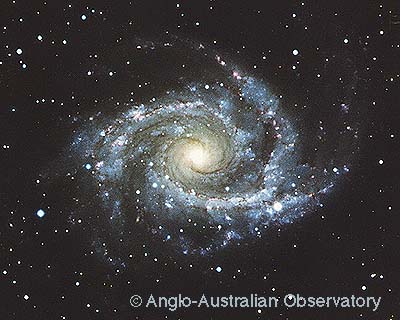
A spiral galaxy in Antlia, NGC 2997. © Anglo-Australian Observatory,
Photograph by David Malin
The local astrophysics community continues to have an international presence
with recent discoveries including spectroscopic observations
of supernova SN 1987A with the 1-metre McLellan telescope, observations of
a highly luminous Gamma-ray Burster by Dr Karen Pollard (University of Canterbury),
evidence for extra-solar planets (MOA New Zealand-Japan collaboration) and
the co-discovery of Nova Velorum 1999 by Alan Gilmore (Mount John University
Observatory).
 Participation in
SALT is an obvious step for the astronomy and astrophysics community.
The construction of a High Resolution Spectrograph for SALT
would combine the advantages of building a high technology optical design and
manufacturing base in New Zealand and allow New Zealand researchers,
engineers, technologists, students and the general public to participate
in a major international science project of the 21st century.
Participation in
SALT is an obvious step for the astronomy and astrophysics community.
The construction of a High Resolution Spectrograph for SALT
would combine the advantages of building a high technology optical design and
manufacturing base in New Zealand and allow New Zealand researchers,
engineers, technologists, students and the general public to participate
in a major international science project of the 21st century.
References
Cottrell and Mackie 1998, Foresight Project - "New Zealand Astronomy and Astrophysics in the
first decade of the new millennium", (an abbreviated version appears in Southern
Stars, 1998, vol. 38, 2, p. 51.)
Mackie, Cottrell and Yock 1998,
"Pass the SALT, Please", New Zealand Science Monthly, November 1998.
Nature, 1998, vol. 393, p. 403.
Nature, 1999, vol. 399, p. 510.
Authors
Dr. Glen Mackie,
School of Chemical and Physical Sciences, Victoria University Wellington and
Carter Observatory
Assoc. Prof. Peter Cottrell,
Dept. of Physics and Astronomy, University of Canterbury
Assoc. Prof. Phil Yock, Faculty of Science, University of Auckland
Appendix: Timeline - New Zealand Astronomy and SALT
'95 onwards
- New Zealand astronomers at the South African Astronomical
Observatory (SAAO) for varying periods:
Drs Karen Pollard (BSc (Hons); PhD Canterbury; Research Fellow SAAO
(1995-7); FRST Postdoctoral Fellow (1997-9)),
Michael Albrow (BSc (Hons); PhD Canterbury; FRST Postdoctoral Fellow
(1994-7) based at Canterbury and SAAO; Marsden Associate Investigator
(1997-2000)),
Prof John Hearnshaw, Assoc Prof Peter Cottrell, Assoc Prof Denis Sullivan.
- Dr David Buckley (BSc, MSc Canterbury) on staff at SAAO following
postdoctoral appointment at University of Cape Town. Dr Buckley is Project
Scientist for SALT.
July '97
- 'Invitation to participate' received from Dr Bob Stobie, Director
SAAO
- Dr Wayne Mapp, MP for North Shore, opened Royal Astronomical
Society of New Zealand's Annual Conference with a challenge to build
momentum for a collaborative large telescope project in New Zealand.
Aug/Sep '97
- Peter Cottrell had extensive discussions with Dr Bob Stobie and
Prof Frank Bash (Chair, Hobby-Eberly Telescope (HET) Board and academic at
The University of Texas at Austin) at IAU General Assembly, Kyoto, Japan
late '97
- Email discussions between New Zealand astronomers:
"What scientific questions are we trying to answer?"
"What facilities are required to answer these questions and to provide
appropriate facilities for future generations of New Zealand astronomers?"
- Considered case for and against 2-m and 10-m telescope proposals:
- 2-m class telescope to be constructed in New Zealand
- Participation in 10-m class telescope in South Africa (SALT)
- SALT considered the best option for raising total profile of New
Zealand astronomy.
March '98
- SALT/HET Workshop in Cape Town. Peter Cottrell (and Denis
Sullivan, VUW) represented New Zealand. Cottrell presented paper entitled
"Astronomical connections between South Africa & New Zealand: past, present
and future".
- Cottrell represented New Zealand at Interim SALT Board Meeting at
Sutherland, site for SALT.
May-Aug '98
- Various talks and discussions in New Zealand and Australia
outlining options for possible New Zealand participation in SALT, including
design, fabrication and commissioning of a high resolution spectrograph for
SALT.
1 June '98
- Announcement of South African Government contribution of $US10
million (50% of construction cost) towards SALT.
(Nature journal, vol. 393, p. 403.).
July '98
- Dr Glen Mackie (Carter Observatory, Wellington) represented New
Zealand at Interim SALT Board Meeting at Carnegie Mellon University in
Pittsburgh.
- Dr Glen Mackie has informal discussions with Dr Bob Tull, Principal
Investigator of HET-High Resolution Spectrograph, at University of Texas
at Austin.
- Professor David Lambert (Dept of Astronomy, The University of
Texas at Austin & McDonald Observatory - site of HET) as Visiting Erskine
Fellow in the Dept of Physics & Astronomy at the University of Canterbury.
- Ministerial letters sent from South African Minister Lionel
Mtshali to New Zealand Foreign Minister Don McKinnon and Minister of
Research, Science & Technology, Maurice Williamson, with copies to
Associate Foreign Minister Simon Upton and Sir Ian Axford as Chair of the
Marsden Fund.
Aug '98
- Assoc Prof Peter Cottrell gives 1st 1998 Carter Memorial Lecture
in Wellington, entitled "What's happening in the world of large
astronomical telescopes? or How New Zealand can participate in a 10m class
telescope".
Sep '98
- Peter Cottrell and Glen Mackie have meetings in Wellington with
Dr James Buwalda (CEO, MRST), Dr Wayne Mapp (MP for North Shore) and Dr
Gerhard von Gruenewaldt (Deputy Chair of the South African Foundation for
Research Development).
Oct '98
- Astronomy & Astrophysics Foresight sector strategy (compiled and
edited by Assoc Prof Peter Cottrell and Dr Glen Mackie from submissions
from the professional astronomical community) submitted to MRST with SALT
as our current highest priority item.
Feb 1 '99
- Submission of SALT Marsden first round proposal. (unsuccessful)
- Submission of SALT Astrophysical Research Centre proposal in
response to the PVC (Research) call for expressions of interest in New
Initiatives in Research at the University of Canterbury. (unsuccessful)
Apr/May '99
- Peter Cottrell attends SALT Interim Board meeting in Cape Town.
Announcements that Polish Astronomical Community ($US3.0M), Rutgers
University, New Jersey ($US1.2M) and Gottingen University, Germany
($US1.3M) had joined the SALT consortium.
June 10 '99
- Announcement in Nature journal (vol 399, page 510) 'Funds promised for
South African telescope' includes mention of New Zealand as 'prospective
partner'.
June 18 '99
- Grant application submitted to University of Canterbury Research
Committee for feasibility study and seed funding for New Zealand
participation in SALT.
July '99
- University of Canterbury Research
Committee awards a grant of $100,000 for SALT feasibility study and seed
funding & Hercules spectrograph.
October '99
- SALT Board meeting - Goettingen, Germany.
December '99
- New Zealand HRS feasibility study carried out by
Prof. Mike Bessell (ANU) and Dr. Peter Gillingham (Anglo-Australian
Observatory).
February 2000
- SALT Board meeting. Wellington, New Zealand.
Appendix: WWW links.
Mackie, Cottrell and Yock 1999, "The Essential Vision", New Zealand
Education Review, Nov. 19, 1999
Text
Cottrell and Mackie 1998, Foresight Project -
"New Zealand Astronomy and Astrophysics in the first decade of the new millennium",
Text,
Cover Page
Mackie, Cottrell and Yock 1998, "Pass the SALT, Please",
New Zealand Science Monthly
Last updated: 16-Dec.-1999

 In 1998,
the South African government approved the construction of
the Southern African Large Telescope (SALT) in Sutherland, Northern
Cape Province. The South African government agreed to contribute 50%
of the capital construction costs with the remaining 50% sourced from
international partners. New Zealand has been asked to join the SALT
project.
In 1998,
the South African government approved the construction of
the Southern African Large Telescope (SALT) in Sutherland, Northern
Cape Province. The South African government agreed to contribute 50%
of the capital construction costs with the remaining 50% sourced from
international partners. New Zealand has been asked to join the SALT
project. 






